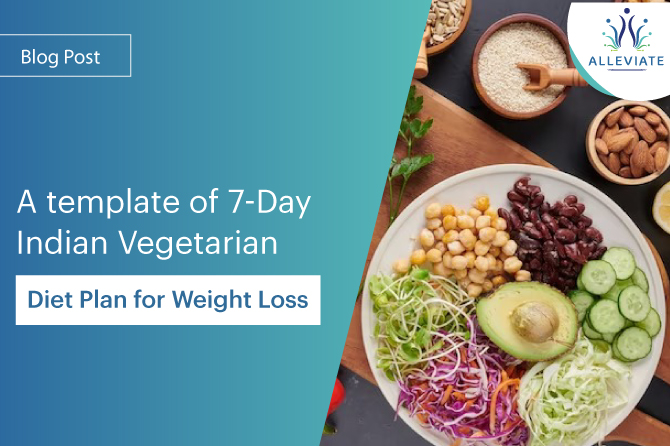
Introduction
Indian cuisine holds a dear place in heart because of its culinary goodness. Indian diet is mostly vegetarian in nature too, but do you know when the portions and macros are used right it can be a great gift to your health.
There is a big misconception that vegetarian diets are not enough to satisfy the body needs, this is not true. Although vegetarian diet might lack some nutrients, by combining foods or by fortification we can easily meet the body nutritional requirements. For example, when we combine rice and dal or beans, we are getting a complete protein – Both brown and white rice are low in lysine but high in methionine. In contrast, beans are high in lysine but low in methionine. Over the years we vegetarian diet has developed well to get nutritionally sufficient.
Having said that, an Indian diet for weight loss can be a real dream come true moment. In this kind of diet, you are losing weight while savouring tasty recipes. Let’s look at such an Indian diet template for weight loss. Please keep in mind to talk to your dietician before stepping into any diet to personalize the plan according to your health goal.
Note – This is a diet plan template based on an average man, to get it customized always talk to your dietician.
Day 1: The Energizing Start
- Breakfast: Soaked blended oatmeal with fresh fruits like apple and banana.
- Lunch: Chapati with vegetable curry
- Snack: Chickpea salad with vegetables
- Dinner: Brown rice with lentils
Day 2: The Nutrient-Rich day
- Breakfast: Moong dal chila with glass of milk.
- Lunch: Whole wheat chapati with soya bean curry
- Snack: Glass of smoothie with banana, mango and yogurt.
- Dinner: Bowl of quinoa and vegetable stir-fry
Day 3: The good Balanced food day
- Breakfast: Bowl of daliya with one fruit
- Lunch: Vegetable fried rice with curd on the side.
- Snack: Bhel puri with lots of vegetables and one citrus fruit
- Dinner: Stir fried tofu with vegetables
Day 4: The Filling and Wholesome day
- Breakfast: Vegetable poha with chai
- Lunch: Bowl of vegetable pulao
- Snack: Bowl of dry roasted makhana
- Dinner: Methi paratha with a bowl of curd.
Day 5: The body Refreshing day
- Breakfast: Fresh fruit salad with a dash of lime juice.
- Lunch: Bowl of brown rice and sambar
- Snack: Roasted papad with salad
- Dinner: Bowl of vegetable millet kichdi
Day 6: The day of Smart choices
- Breakfast: Paneer paratha with curd
- Lunch: Bowl of brown rice with moong dal
- Snack: Bowl of clear soup with grilled vegetable sandwiches
- Dinner: Vegetable biryani with raita
Day 7: At last a Satisfying end
- Breakfast: Millet dosa with green chutney
- Lunch: Jawar roti with sprouts sabzi
- Snack: Fresh fruit juice
- Dinner: Bowl of rajma with brown rice
Conclusion
This 7-day Indian vegetarian diet plan combines a variety of nutrient-dense foods to help you achieve your weight loss goals while ensuring you receive essential vitamins, minerals, and protein. Remember, before starting any diet plan, it’s crucial to consult with a healthcare professional or registered dietitian to ensure it aligns with your specific health needs.
References
- Tappy, L., & Lê, K. A. (2010). “Metabolic Effects of Fructose and the Worldwide Increase in Obesity.” Physiological Reviews, 90(1), 23-46.
- Jenkins, D. J., Kendall, C. W., Augustin, L. S., Mitchell, S., Sahye-Pudaruth, S., Blanco Mejia, S., … & Josse, R. G. (2012). “Effect of Legumes as Part of a Low Glycemic Index Diet on Glycemic Control and Cardiovascular Risk Factors in Type 2 Diabetes Mellitus: A Randomized Controlled Trial.” Archives of Internal Medicine, 172(21), 1653-1660.
- Mah, E., Garcia-Campayo, V., Liska, D., Trill, J., Fuentes-Arderiu, X., & Bruker, P. (2017). “Inulin and Oligofructose in the Dietary Fibre Concept.” British Journal of Nutrition, 93(S1), S111-S144.
- Nukala, S., P. Sastry, T. and Karakala, B., 2016. “A Study on the Hypolipidemic Effect of Fenugreek Seeds (Trigonella Foenum-Graecum) in Hyperlipidemic Rats.” Journal of Clinical and Diagnostic Research, 10(10), FF06-FF10.
- Pal, S., & Ellis, V. (2010). “The Chronic Effects of Whey Proteins on Blood Pressure, Vascular Function, and Inflammatory Markers in Overweight Individuals.” Obesity, 18(7), 1354-1359.
- Poovitha, S., Parani, M. (2012). “Inhibitory Efficacy of Cumin Essential Oil on Pathogenic and Spoilage Microorganisms.” BioMed Research International, 2014, 1-8.













Leave a reply